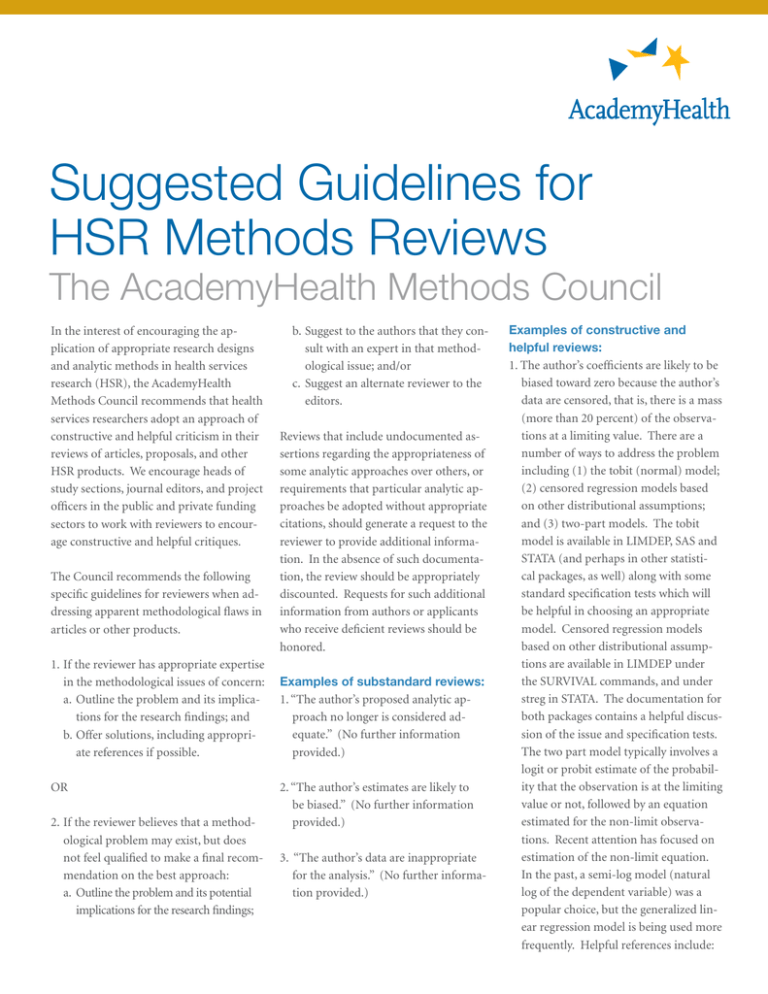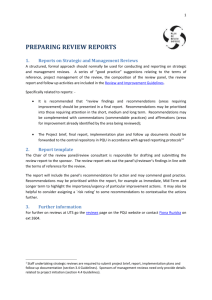In the interest of encouraging the ap- Examples of constructive and
advertisement

Suggested Guidelines for HSR Methods Reviews The AcademyHealth Methods Council In the interest of encouraging the application of appropriate research designs and analytic methods in health services research (HSR), the AcademyHealth Methods Council recommends that health services researchers adopt an approach of constructive and helpful criticism in their reviews of articles, proposals, and other HSR products. We encourage heads of study sections, journal editors, and project officers in the public and private funding sectors to work with reviewers to encourage constructive and helpful critiques. The Council recommends the following specific guidelines for reviewers when addressing apparent methodological flaws in articles or other products. 1.If the reviewer has appropriate expertise in the methodological issues of concern: a. Outline the problem and its implications for the research findings; and b.Offer solutions, including appropriate references if possible. OR 2.If the reviewer believes that a methodological problem may exist, but does not feel qualified to make a final recommendation on the best approach: a. Outline the problem and its potential implications for the research findings; b.Suggest to the authors that they consult with an expert in that methodological issue; and/or c. Suggest an alternate reviewer to the editors. Reviews that include undocumented assertions regarding the appropriateness of some analytic approaches over others, or requirements that particular analytic approaches be adopted without appropriate citations, should generate a request to the reviewer to provide additional information. In the absence of such documentation, the review should be appropriately discounted. Requests for such additional information from authors or applicants who receive deficient reviews should be honored. Examples of substandard reviews: 1. “The author’s proposed analytic approach no longer is considered adequate.” (No further information provided.) 2. “The author’s estimates are likely to be biased.” (No further information provided.) 3. “The author’s data are inappropriate for the analysis.” (No further information provided.) Examples of constructive and helpful reviews: 1. The author’s coefficients are likely to be biased toward zero because the author’s data are censored, that is, there is a mass (more than 20 percent) of the observations at a limiting value. There are a number of ways to address the problem including (1) the tobit (normal) model; (2) censored regression models based on other distributional assumptions; and (3) two-part models. The tobit model is available in LIMDEP, SAS and STATA (and perhaps in other statistical packages, as well) along with some standard specification tests which will be helpful in choosing an appropriate model. Censored regression models based on other distributional assumptions are available in LIMDEP under the SURVIVAL commands, and under streg in STATA. The documentation for both packages contains a helpful discussion of the issue and specification tests. The two part model typically involves a logit or probit estimate of the probability that the observation is at the limiting value or not, followed by an equation estimated for the non-limit observations. Recent attention has focused on estimation of the non-limit equation. In the past, a semi-log model (natural log of the dependent variable) was a popular choice, but the generalized linear regression model is being used more frequently. Helpful references include: Manning, W.G. “The logged dependent variable, heteroskedasticity, and the retransformation problem,” Journal of Health Economics, Vol. 17 No. 3, 1988, pp. 283-96. Manning, W.G. and J. Mullahy. “Estimating Log Models: To Transform or Not to Transform,” Journal of Health Economics, Vol. 20, 2001, pp. 461-94. Mullahy, J. “Much Ado about Two: Reconsidering Retransformation and the Two-part Model in Health Econometrics,” Journal of Health Economics, Vol. 17 No. 3, 1988, p. 2826. The glm command in STATA provides a useful set of estimation options. 2. The author is estimating the effect of employment status on the probability that the subject has health insurance. 2 The estimated coefficient on employment status is likely to be subject to omitted variables bias in the author’s cross-sectional data on subjects in the individual health insurance market, because health status (unobserved in the author’s data) plausibly has a causal effect on both employment status and health insurance status. In addition, the availability of health insurance could influence the individual’s access to care and thus his or her health status and subsequent ability to work. This is a case of reverse causality. Both problems can be addressed through the use of instrumental variables or sample selection models. The data requirements for the two estimation methods are identical: the author needs a variable that affects employment status, but has no direct effect on (i.e., is uncorrelated with the error term in) the insurance status equation. 3. The author has used the National Health Interview Survey (NHIS) to track obesity trends in the United States. The BMI measure in the NHIS from which obesity rates are determined relies on reported height and weight, which we know underestimate obesity. A better data set to use, if feasible, would be the National Health and Nutrition Examination Survey (NHANES), which collects measured as well as self-reported height and weight. The NHANES sample sizes, however, may be too small for the detailed covariate analysis that the author wished to undertake. Possible options include pooling more years for comparisons or providing less covariate detail. If the authors and the editors decide that the larger sample size and more detailed covariate information in the NHIS outweigh the underreporting bias, the article should clearly state the limitations of the obesity measure.


